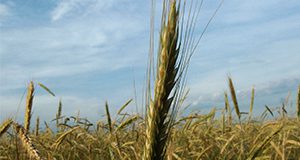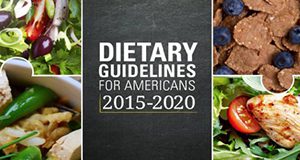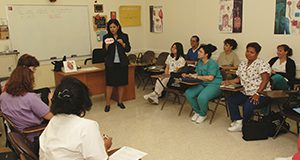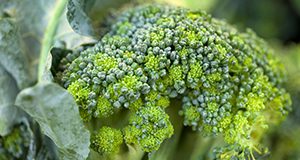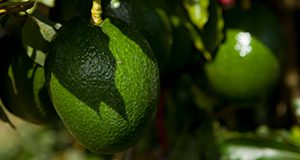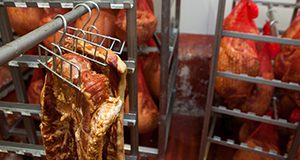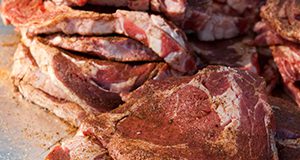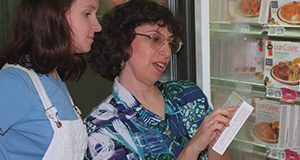 The U.S. Food and Drug Administration (FDA) requires that most food packages have the Nutrition Facts label. This label contains information about nutrients in the food to help people make healthier food choices. Older adults can use the label to choose foods that provide required daily nutrients or fit with a diet plan to manage a disease or health condition. This 4-page fact sheet is a major revision that discusses the Nutrition Facts label, checking calories, limiting certain nutrients, % Daily Values, and consuming enough fiber, vitamin D, potassium, calcium, and iron. Written by Linda B. Bobroff and Karla P. Shelnutt, and published by the UF Department of Family, Youth and Community Sciences, revised May 2017.
The U.S. Food and Drug Administration (FDA) requires that most food packages have the Nutrition Facts label. This label contains information about nutrients in the food to help people make healthier food choices. Older adults can use the label to choose foods that provide required daily nutrients or fit with a diet plan to manage a disease or health condition. This 4-page fact sheet is a major revision that discusses the Nutrition Facts label, checking calories, limiting certain nutrients, % Daily Values, and consuming enough fiber, vitamin D, potassium, calcium, and iron. Written by Linda B. Bobroff and Karla P. Shelnutt, and published by the UF Department of Family, Youth and Community Sciences, revised May 2017.
http://edis.ifas.ufl.edu/fy1127
Category: Health & Nutrition
Raising Healthy Children: Wheat Allergies
If your child has been diagnosed with a wheat allergy, you may be wondering what you will feed him or her, because wheat is an ingredient in so many foods. Learning about ways to manage and treat your child’s allergy can help make this diagnosis less scary. This six-page publication is designed to provide you with information about wheat allergies and tips to help keep your child safe and reaction-free. Written by Pooja Tolani and Gail P.A. Kauwell and published by the Food Science and Human Nutrition Department.
http://edis.ifas.ufl.edu/fs299
Vida Saludable: Diabetes
La diabetes es una condición que ocurre cuando el cuerpo tiene dificultad para producir o utilizar la insulina. La insulina es una hormona que controla la cantidad de glucosa (azúcar) en nuestra sangre, informándole a las células cuanta glucosa pueden dejar entrar. Cuando una persona tiene diabetes, el cuerpo no produce o produce poca insulina, o produce una insulina que no funciona bien. Esto resulta en altos niveles de glucosa en la sangre. Controlar los niveles de glucosa en la sangre reduce el riesgo de otras complicaciones.
This 2-page fact sheet is a major revision that discusses diabetes and management techniques. Written by Linda B. Bobroff and Paulina Wittkowsky, and published by the UF Department of Family, Youth and Community Sciences, revised June 2017.
http://edis.ifas.ufl.edu/fy081
Choosing Healthy Meals As You Get Older: 10 Healthy Eating Tips for People Age 65+
After introducing MyPlate in June 2011, USDA provided a series of fact sheets to help consumers use the dietary advice of the Dietary Guidelines 2010. USDA continues to add fact sheets to the series, reflecting the most current Dietary Guidelines and issues important to consumers. This fact sheet was developed by the Center for Nutrition Policy and Promotion/USDA in partnership with the National Institute on Aging/National Institutes of Health, with an introduction by Linda B. Bobroff. This series of fact sheets is distributed by UF/IFAS Extension, June 2017.
http://edis.ifas.ufl.edu/fy1474
Seven New Spanish Translations in Food Science and Human Nutrition

The following new Spanish translations have been published in the Food Science and Human Nutrition Department:
- FS291/FSHN15-10S Enfermedad renal crónica: fósforo y su dieta by Nancy J. Gal, Lauren Headrick, Kate Bennett, and Wendy J. Dahl http://edis.ifas.ufl.edu/fs291
- FS292/FSHN16-3S Datos sobre grasas y aceites by Tiffany N. Stodtko and Wendy J. Dahl http://edis.ifas.ufl.edu/fs292
- FS293/FSHN16-9S Enfermedad renal crónica: Potasio y su dieta by Ashley R. Kendall, Nancy J. Gal, and Wendey J. Dahl http://edsi.ifas.ufl.edu/fs293
- FS294/FSHN16-1S Alimentos en puré: Guía para comidas rápidas by Wendy J. Dahl http://edis.ifas.ufl.edu/fs294
- FS295/FSHN12-18S Conteo de carbohidratos: Comidas para la Diabetes by Cassie Rowe, Jamila R. Lepore, and Wendy J. Dahl http://edis.ifas.ufl.edu/fs295
- FS296/FSHN16-4S Beneficios para la salud del aceite de olive y extractos de oliva by Wendy J. Dahl, Michael A. Tandlich, and Julie England http://edis.ifas.ufl.edu/fs296
- FS297/FSHN16-8S Una guía sobre probióticos y salud by Wendy J. Dahl http://edis.ifas.ufl.edu/fs297
Dietary Guidelines for Americans 2015–2020: A Summary
About half of all adult Americans have at least one chronic disease that could be prevented. Many of these preventable chronic diseases are related to poor eating and physical activity habits. The good news is that the risk of chronic diseases, such as heart disease, high blood pressure, and type 2 diabetes, can be reduced with the help of the 2015 Dietary Guidelines for Americans, which is described in this five-page fact sheet. Written by Kelly Johnston and Karla P. Shelnutt and published by the Food Science and Human Nutrition Department.
http://edis.ifas.ufl.edu/fs298
High Blood Pressure: What You Need to Know
High blood pressure, also called hypertension, increases your health risks. If you have high blood pressure, you have a higher chance of developing heart or kidney disease or having a stroke. This 4-page fact sheet discusses medical problems associated with untreated high blood pressure, risk factors, risk reduction, causes, and prevention. Written by Linda B. Bobroff, and published by the UF Department of Family, Youth and Community Sciences, revised October 2016.
http://edis.ifas.ufl.edu/fy199
Prevent Osteoporosis: Catch the Silent Thief
Osteoporosis means porous bones, or bones that have so many openings (pores) that they can easily break or be crushed. In the United States, 54 million people either have osteoporosis (10 million) or are at high risk (44 million) because they have low bone mass. By 2020, one in two Americans over the age of 50 is expected to have osteoporosis of the hip or be at high risk of developing the condition. This 11-page fact sheet discusses risk factors, calcium for bone building, calcium-rich foods, calcium supplements, vitamin D, and exercise. Written by Linda B. Bobroff, and published by the UF Department of Family, Youth and Community Sciences, revised February 2017.
http://edis.ifas.ufl.edu/fy469
Carotenoids and Eye Health
A diet rich in colorful fruits and vegetables provides a variety of nutrients as well as phytochemicals that can promote health. Lutein and zeaxanthin are two non-provitamin A carotenoids that may be protective against AMD, the leading cause of permanent central vision loss in older adults. This 3-page fact sheet provides an overview of carotenoids, AMD, lutein, zeaxanthin, risk factors for AMD, and good sources of lutein and zeaxanthin. Written by Linda B. Bobroff, and published by the UF Department of Family, Youth and Community Sciences, revised October 2016.
http://edis.ifas.ufl.edu/fy1217
Nutrition for Health and Fitness: Fat in Your Diet
We frequently hear about the epidemic of obesity. We also hear a variety of recommendations for how much and what type of fat we should have in our diets. With new research being published all the time, it can get confusing for consumers. This 8-page fact sheet is a major revision that provides tips to help individuals meet dietary guidelines and reduce health risks, as well as a few tasty recipes to try. Written by Linda B. Bobroff, and published by the UF Department of Family, Youth and Community Sciences, revised March 2017.
http://edis.ifas.ufl.edu/he695
Preventing Foodborne Illness: Bacillus cereus
Ingesting foods contaminated with Bacillus cereus bacteria can lead to nausea, vomiting, abdominal cramps, and diarrhea. Though B. cereus is commonly found in many types of fresh and processed foods, proper cooking, handling, and storage can minimize the risk of contamination. This 5-page fact sheet explains how B. cereus is transmitted, what foods it is commonly associated with, the methods used to prevent contamination, and good practices for receiving, handling, processing, and storing food. Written by Keith R. Schneider, Renée Goodrich Schneider, Rachael Silverberg, Ploy Kurdmongkoltham, and Bruna Bertoldi, and published by the Department of Food Science and Human Nutrition.
http://edis.ifas.ufl.edu/fs269
Food Insecurity and Obesity
Food insecurity is prevalent across the US and often coexists with obesity. It is important that the coexistence of food insecurity and obesity is well understood so that community outreach programs and interventions can continue to be implemented in order to improve food security by increasing access to affordable, healthy foods and promoting good health nationwide. This 4-page fact sheet discusses food insecurity, reduced access to healthy food options, the cycle of food excess and deprivation, SNAP, the WIC program, and child nutrition programs. Written by Rachel Savelle and LaToya J. O'Neal, and published by the UF Department of Family, Youth and Community Sciences, February 2017.
http://edis.ifas.ufl.edu/fy1473
Protein and the Older Adult

Protein is a nutrient that provides energy for our bodies and is involved in many vital functions, such as repair, maintenance, and immune function. This three-page document discusses the protein requirements for older adults. Written by Amanda L. Ford and Wendy J. Dahl and published by the Food Science and Human Nutrition Department.
http://edis.ifas.ufl.edu/fs290
Citrus Flavonoid Effects on Obesity
The increased prevalence of obesity in recent decades has sparked tremendous concern worldwide. A type of phytochemical, called flavanoids, has been shown in clinical trials to provide significan benefits to overall health because of their antioxidant abilities. Flavanoids are especially abundant in citrus species. This two-page fact sheets describes the health benefits of citrus flavanoids. Written by Yu Wang and Laura Reuss and published by the Food Science and Human Nutrition Department.
http://edis.ifas.ufl.edu/fs285
Coconut Oil: A Heart Healthy Fat?
There are many claims about the health benefits of coconut oil. But what is the evidence behind these health claims? Read this five-page fact sheet to learn more about coconut oil and how it might affect heart health. Written by Wendy M. Gans and Gail P.A. Kauwell and published by the Food Science and Human Nutrition department.
http://edis.ifas.ufl.edu/fs289
Florida 4-H Tailgate: Smoking and Slow Cooking Meat
The Florida 4-H Poultry BBQ program has existed for years, and the program for red meat cookery has been a huge success in Tennessee 4-H. With sponsorship for the winners at the state level, the Florida 4-H Tailgate Contest program will be a success in Florida as well. This program will strive to promote enjoyable outdoor cooking experiences, encourage the incorporation of animal protein in the diet in order to combat childhood obesity, improve youth nutritional knowledge and cooking skills, and impart knowledge about safe handling and proper degree of doneness to produce safe and delicious meat dishes. This 2-page fact sheet is the fourth publication in the Florida 4-H Tailgate series, and it discusses smoking and slow cooking meat. Written by Chad Carr, Brian Estevez, Sonja Crawford, Jason Scheffler, George Baker, Ed Jennings, and Mark Mauldin, and published by the 4-H Youth Development Department, December 2016.
http://edis.ifas.ufl.edu/4h375
Alimentos en Pure: Prueba de Textura con la Prueba de Desplome
This is the Spanish version of FS276 Pureed Foods: Texture Testing with the Slump Test. For individuals with dysphagia, the texture of puréed foods is extremely important. If the puréed foods are either too thick or too thin, it can make it more difficult to swallow. The slump test is a quick, easy, and inexpensive way to assess the texture of foods. This four-page fact sheet describes the slump test, how to perform a slump test, and how the slump test can be used to evaluate the texture of puréed foods. Written by Wendy J. Dahl, and published by the Food Science and Human Nutrition Department.
http://edis.ifas.ufl.edu/fs288
Florida 4-H Tailgate: Fire-Building
The Florida 4-H Poultry BBQ program has existed for years, and the program for red meat cookery has been a huge success in Tennessee 4-H. With sponsorship for the winners at the state level, the Florida 4-H Tailgate Contest program will be a success in Florida as well. This program will strive to promote enjoyable outdoor cooking experiences, encourage the incorporation of animal protein in the diet in order to combat childhood obesity, improve youth nutritional knowledge and cooking skills, and impart knowledge about safe handling and proper degree of doneness to produce safe and delicious meat dishes. This 2-page fact sheet is the third publication in the Florida 4-H Tailgate series, and it discusses fire-building. Written by Chad Carr, Brian Estevez, Sonja Crawford, Jason Scheffler, George Baker, Ed Jennings, and Mark Mauldin, and published by the 4-H Youth Development Department, December 2016.
http://edis.ifas.ufl.edu/4h374
Florida 4-H Tailgate: Meat Selection
The Florida 4-H Poultry BBQ program has existed for years, and the program for red meat cookery has been a huge success in Tennessee 4-H. With sponsorship for the winners at the state level, the Florida 4-H Tailgate Contest program will be a success in Florida as well. This program will strive to promote enjoyable outdoor cooking experiences, encourage the incorporation of animal protein in the diet in order to combat childhood obesity, improve youth nutritional knowledge and cooking skills, and impart knowledge about safe handling and proper degree of doneness to produce safe and delicious meat dishes. This 2-page fact sheet is the fifth publication in the Florida 4-H Tailgate series, and it discusses meat selection. Written by Chad Carr, Brian Estevez, Sonja Crawford, Jason Scheffler, George Baker, Ed Jennings, and Mark Mauldin, and published by the 4-H Youth Development Department, December 2016.
http://edis.ifas.ufl.edu/4h376
Florida 4-H Tailgate: Cooking Safety
The Florida 4-H Poultry BBQ program has existed for years, and the program for red meat cookery has been a huge success in Tennessee 4-H. With sponsorship for the winners at the state level, the Florida 4-H Tailgate Contest program will be a success in Florida as well. This program will strive to promote enjoyable outdoor cooking experiences, encourage the incorporation of animal protein in the diet in order to combat childhood obesity, improve youth nutritional knowledge and cooking skills, and impart knowledge about safe handling and proper degree of doneness to produce safe and delicious meat dishes. This 3-page fact sheet is the second publication in the Florida 4-H Tailgate series, and it addresses cooking safety. Written by Chad Carr, Brian Estevez, Sonja Crawford, Jason Scheffler, George Baker, Ed Jennings, and Mark Mauldin, and published by the 4-H Youth Development Department, December 2016.
http://edis.ifas.ufl.edu/4h373
